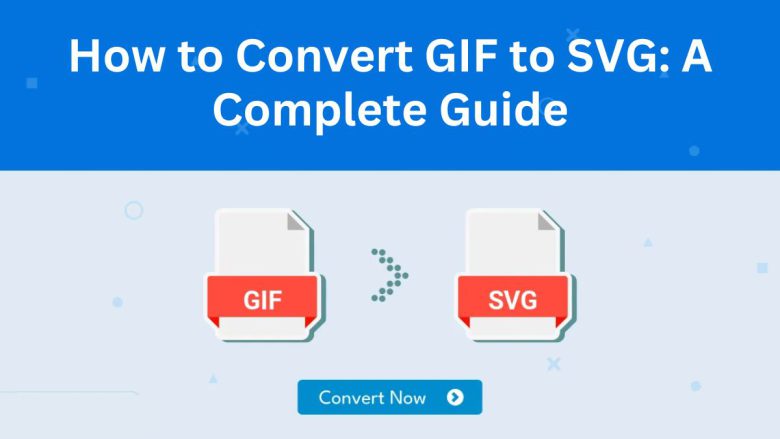
Converting files from one format to another is a common need in the digital world. One such useful conversion is GIF to SVG. GIF (Graphics Interchange Format) is popular for short, simple animations. SVG (Scalable Vector Graphics) is an XML-based vector format. It provides high-quality graphics and infinite scalability without losing resolution.
This blog will explore the benefits of converting GIF to SVG. We will also cover how to do it using FileProInfo’s GIF to SVG Converter. Finally, we will discuss its practical uses. By the end of this guide, you’ll be equipped to easily convert GIF to SVG and understand how it can enhance your digital projects.
Why Convert GIF to SVG?
Both GIF and SVG serve different purposes in the world of digital graphics. While GIF is primarily used for short animations, SVG is a vector format that provides clear, scalable images without any loss of quality. There are several reasons why you might want to convert GIF to SVG.
1. Scalability
SVG images are vector-based, meaning they can be scaled infinitely without losing image quality. This is in contrast to GIFs, which are raster images that can become pixelated when enlarged. By converting your GIF to SVG, you gain the advantage of scalability, making your image look sharp and clear at any size.
2. Improved File Size
SVG files are often smaller in size compared to GIFs, especially for complex images. This reduction in file size can make your website or project load faster, improving user experience and saving bandwidth.
3. Interactive Capabilities
Unlike GIFs, SVG allows for interactivity and animation using CSS or JavaScript. This makes it a more versatile format, especially for websites and apps where you want to add dynamic effects to your images.
4. Editable with Code
One of the most significant advantages of SVG is that it’s XML-based, meaning you can edit the image using a text editor or code. This gives designers and developers more flexibility. They can modify and customize images directly through code. It’s much harder to do this with a GIF file.
5. High-Quality Graphics
Since SVG is a vector format, it supports high-quality, crisp graphics. This makes it a better choice for logos, icons, charts, and illustrations, where clarity and detail are essential.
6. Cross-Platform Compatibility
SVG files are supported across modern web browsers and platforms. They are universally compatible. So, you can display an SVG file on any device. GIFs might have some limitations.
What is GIF?
Before we get into the conversion process, let’s take a closer look at GIF as a format.
GIF (Graphics Interchange Format) was introduced in 1987. It is now synonymous with short, looping animations. GIFs support only 256 colors. Still, they are popular for simple animations, reactions, and memes.
Key Features of GIF:
- Limited Color Palette: Only supports 256 colors, which can limit image quality for complex visuals.
- Supports Animation: GIFs are capable of storing multiple frames, making them perfect for short animations.
- Universal Compatibility: GIFs are widely supported on most platforms, but their quality may degrade when resized or used for more complex graphics.
What is SVG?
SVG (Scalable Vector Graphics) is a newer format. The W3C introduced it as a standard in 2001. SVG is an XML-based vector image format that is perfect for scalable, high-quality graphics. It’s especially useful for web apps and designs. It has high resolution, small file sizes, and easy integration with HTML, CSS, and JavaScript.
Key Features of SVG:
- Scalability: SVG can be scaled infinitely without losing quality.
- Editable via Code: SVG files can be edited and manipulated using text editors and code.
- Smaller File Size: Generally smaller than GIFs, especially for images with geometric shapes and flat colors.
- Supports Interactivity: SVGs can be animated and made interactive using CSS and JavaScript.
How to Convert GIF to SVG Using FileProInfo
Now that you know the benefits of converting GIFs to SVGs, let’s use FileProInfo’s GIF to SVG Converter. I’ll walk you through the steps. This tool is completely free, fast, and user-friendly.
Step 1: Access the FileProInfo GIF to SVG Converter
To start the conversion, head over to the FileProInfo GIF to SVG Converter. This tool allows you to upload your GIF file and convert it to SVG format within seconds without needing any software downloads.
Step 2: Upload Your GIF File
Click on the “Choose File” button or drag and drop your GIF file into the designated area. Ensure that your file does not exceed the 150 MB file size limit, which is more than enough for most animated or static GIFs.
Step 3: Start the Conversion Process
Once your GIF file is uploaded, hit the “Convert” button. The tool will process your file and convert it into the SVG format. The conversion usually takes just a few seconds, depending on the size of your file.
Step 4: Download the Converted SVG File
Once the conversion is complete, you’ll be provided with a download link. Click the link to download your newly converted SVG file to your device. You’re now ready to use your SVG file in your project, whether it’s for a website, design, or any other purpose.
Benefits of Using FileProInfo’s GIF to SVG Converter
FileProInfo’s GIF to SVG Converter is an excellent tool for anyone looking to convert files online quickly and securely. Here are a few reasons why this tool stands out:
1. Free and Easy to Use
FileProInfo offers a completely free conversion service with no hidden costs. The interface is user-friendly, so even if you’re not a tech expert, you can convert your GIF files to SVG in just a few clicks.
2. Fast and Efficient
The conversion process on FileProInfo is fast. You don’t have to wait long for your file to be converted—within seconds, your SVG file will be ready to download.
3. No Software Installation
Since the conversion is done online, there’s no need to install any software or plugins on your device. All you need is your web browser.
4. Secure and Private
FileProInfo takes your privacy seriously. We process your files securely. They are deleted from the server shortly after conversion. This ensures your data is safe.
5. Cross-Platform Support
You can use the FileProInfo converter on any device—whether it’s Windows, macOS, Android, or iOS. The tool works seamlessly across all major browsers and devices.
Practical Applications for Converting GIF to SVG
The conversion from GIF to SVG has practical applications across many fields. Here are a few scenarios where this conversion might come in handy:
1. Web Design and Development
SVG files are perfect for websites due to their scalability and small file sizes. By converting GIF to SVG, you can ensure that your graphics remain crisp and clear across devices with different screen sizes.
2. Logo Design
Since logos often need to be resized for various purposes, using SVG ensures that they retain their quality regardless of size. Converting your GIF logo to SVG gives you greater flexibility in its usage.
3. Infographics
SVG is the best choice for infographics due to its ability to scale without losing quality. If you have a GIF-based infographic, converting it to SVG will allow you to present the content more clearly.
4. User Interfaces
Modern web apps often use SVG for buttons, icons, and illustrations. SVG is versatile, so it’s great for interactive elements. Converting GIF to SVG will allow you to use scalable icons that can be animated using CSS or JavaScript.
5. Digital Marketing
SVGs can be embedded in websites or email campaigns, providing clear, sharp graphics with minimal impact on loading times. If you’ve been using GIFs for banners or other digital marketing assets, switching to SVG may improve performance.
Frequently Asked Questions (FAQs)
1. Is FileProInfo’s GIF to SVG Converter Safe?
Yes, FileProInfo’s converter is safe to use. We process your files securely. They are deleted after conversion, ensuring your data privacy.
2. Can I Use the Converter on Mobile?
Absolutely! FileProInfo’s converter works seamlessly on both desktop and mobile devices. You can convert files from your smartphone or tablet without any issues.
3. Is There a File Size Limit for Conversion?
Yes, the maximum file size for conversion is 150 MB, which should be sufficient for most GIF files, whether animated or static.
Conclusion
Converting GIF to SVG has many benefits. It improves scalability, reduces file size, and allows image editing and interaction. Use FileProInfo’s GIF to SVG Converter. It lets you quickly and easily switch formats. Your graphics will be high-quality, versatile, and future-proof.
Whether you’re working on web design, logo creation, or any other project that involves graphics, making the move from GIF to SVG is a smart step. Try FileProInfo’s converter. It’s a free, fast, and easy way to convert files!


